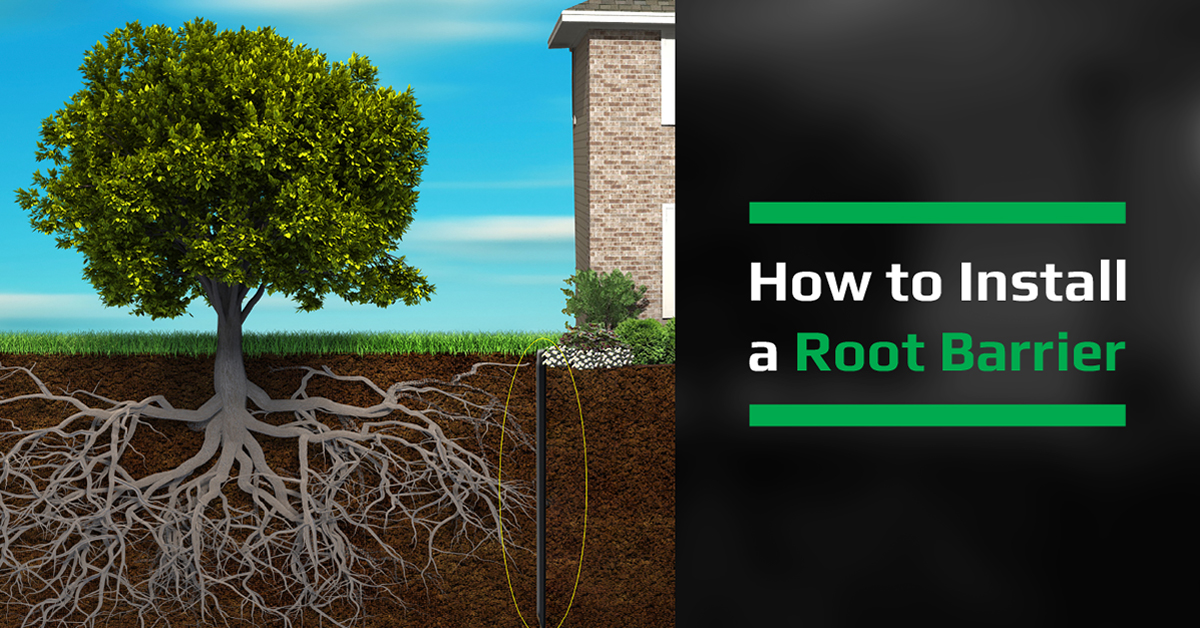
Trees and screening plants like bamboo are staples of any well-landscaped area. They clean the air of carbon dioxide, cool living spaces, bear fruit for our tables, provide a habitat for birds and wildlife — the list goes on.
While trees and bamboo are beautiful, their roots can be destructive to foundations, concrete structures, utility pipes and drain fields. If you are planting a new tree or bamboo plant, installing a root barrier along with it will save you time, money and hassle in the long run. And if it’s an existing plant that’s wreaking havoc on neighboring crops or structures, a root barrier is critical to repairing damage caused and preventing more issues going forward.
Here, we’ll explain what root barriers are, why they are important and how to install them for a variety of applications.
Contact our experts today at 760-388-6294.
What is a Root Barrier?
A root barrier is essentially just what it sounds like: a mechanism that prevents the spreading of underground tree roots and resulting damage to nearby structures. Root barriers come in physical and chemical forms, with the latter preventing the growth of tree roots by destroying them altogether, often taking the surrounding plant life with them. For that reason, we recommend the less destructive, more environmentally-friendly option of installing a physical root barrier.
Physical root barriers simply redirect roots without harming the tree or bamboo. A high-density polyethylene (HDPE) root barrier acts as a waterproof seal to prevent the loss of moisture in soil while protecting foundations, utility piping, hardscapes and pavements from damage.
Why Should I Use a Root Barrier?
There are many reasons to consider installing a root barrier, from protecting the well-being of your plants to preventing trip-and-fall hazards in yards, driveways and on sidewalks.
Root barriers can keep tree roots from invading garden soil and depriving your plants of moisture. If your crops aren’t quite thriving like they used to but that big old oak tree in the backyard has never looked healthier, you may want to take a peek beneath the soil. If you’ve got wooden roots where beetroots should be, it’s probably time to install a root barrier.
While root barriers can help create an environment where all plants can coexist in harmony, depending on the location of the tree in question, they can also be a critical safety consideration. Tree roots growing under sidewalks, for example, can cause the concrete to lift, creating a tripping hazard and potential liability (especially in public spaces). If the tree is on your property, root barriers can help prevent costly damage to yards, swimming pools, driveways and the foundation as a whole.
When and How to Install a Root Barrier
Ideally, root barriers should be installed before planting a tree or bamboo plant in order to properly direct the roots from the start and avoid disruption to the root system. However, we understand this isn’t always feasible — and that, more often than not, the need for a root barrier doesn’t become known until later down the road when the issue can no longer be ignored. Whether you are starting fresh or mitigating an existing tree or bamboo plant, a successful installation begins with a flexible, high-quality root barrier that conforms to the space while resisting tears and punctures.
Linear Barrier vs. Surrounding Root Barrier Installation
Root barriers can be installed in either a linear or surrounding fashion. Linear installation is generally best-suited for trees that are up against concrete sidewalks or curbs, allowing you to install the barrier only on the side of the tree at risk of impacting the foundation.
How deep should you install a root barrier system?
When determining how deep to install a root barrier, consider the type of plants or trees nearby and the soil conditions. Here are some general guidelines to help.
12 – 18 inches is usually a sufficient depth to prevent most shrub roots and small trees from spreading and intruding into unwanted areas like sidewalks or garden beds.
24-36 inches works well for most medium-sized trees, but larger varieties may require a deeper barrier if close to hardscaping or structures.
36-48 inches is recommended for aggressive or invasive root systems that may require a deeper barrier to effectively protect foundations, pipes, and pavement.
Up to 60 inches is ideal for extreme situations with expansive clay soils or where the plant species naturally has a large root system.
In all cases, the barrier should be installed vertically with the top edge at least 1–2 inches (2.5–5 cm) above the soil to prevent roots from growing over it. Consulting an arborist can ensure the best depth and placement for larger installations or specific plants for long-term effectiveness.
Root Barrier Installation for New Trees
Planting a new tree is the best time to install a tree root barrier, as this will allow the roots to grow naturally in the direction you set. Here’s a quick breakdown below — for a more comprehensive explanation, check out this step-by-step guide.
- Plan & Measure. First, measure the diameter of the trunk and multiply that number by three, rounding up rather than down (in this case, a little extra room is a good thing). Then, measure the length of the root barrier, dividing that number by the width of its panels. This will tell you how many panels you need.
- Get to Digging. Once you know where you’re installing the root barrier, dig a trench. The depth for most trees is 24” – 36”, less 1 inch if you plan to catch surface roots as well. The trench width should be approximately three-to-four inches wide.
- Install Your Root Barrier. Insert each panel of your root barrier into the trench, making sure it sticks out at least one or two inches above-ground. Replace the dirt, alternating one-third dirt, then water, then dirt, and so on until the trench is backfilled to ground level.
Root Barrier Installation for Existing Trees
Installing a root barrier for an existing tree is a similar process to that of a new tree — that is, until you get down to the roots. Depending on the type, age and size of the tree — and the extent of the root spread — it might be necessary to cut back some of the roots, which may be best handled by a professional. (On that note, it’s probably not a bad idea to get the advice of a professional landscaper or arborist, especially if this is your first root-mitigating go-round).
Special Considerations for Bamboo Root Barriers
Because bamboo grows at such a rapid pace, containment is crucial. Installing a bamboo root barrier (also called a rhizome barrier) follows essentially the same process as installing a tree root barrier — the main difference is in the measurements. For timber bamboo projects, we recommend a custom-fabricated HDPE geomembrane liner, which is engineered to perform in extended exposure to outdoor conditions. Because HDPE is custom fabricated to size and specifications, it is a versatile option ideal for unwieldy bamboo plants.
Materials to Use for Root Barriers
Whether you’re ready to plant a new tree or need to mitigate damage from an existing one, Americover can provide you with the materials to create a happy and healthy environment for all of your plant life. Browse our selection of high-quality root barriers and rhizome barriers, or give us a call at 760-388-6294 to discuss the right solution for your space. And, be sure to check out the video below for a visual guide to installing a root barrier.
Video: What is a Root Barrier and How Do I Install it?
Shop Americover By Catalog
To browse our full inventory of plastic and polyethylene products, sign up to receive our catalog by mail, or access a digital copy here.
Get in Touch
As an Americover customer, you will receive the personalized support of a dedicated account manager to simplify the ordering process and ensure the best solution for every one of your projects. Our friendly, knowledgeable staff is here to answer your questions and fulfill orders Monday-Friday from 6 a.m. to 6:30 p.m. Pacific Standard Time.
I am text block. Click edit button to change this text. Lorem ipsum dolor sit amet, consectetur adipiscing elit. Ut elit tellus, luctus nec ullamcorper mattis, pulvinar dapibus leo.
